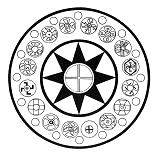|

Lemurian mandala,
outer ring of 16 points around inner ring of 8 points
|
The Chinese astrology and Feng Shui were born along the Silk Road
Introduction
Most practitioners compare the Chinese geomancy arts to some extent, but do not delve deep into the historical roots and origins of their arts. Many have a superstitious view of the workings of the arts and run after "magical formulas" without realising much of these are only nonsense. Greater scholarly understanding of the historical origins can objectively improve current practice of astrology and Feng Shui.
As part of the research into the Chinese geomancy arts, I and some of my students decided to visit the Silk Road. Even in ancient China, the Silk Road represents a far away mysterious region. Legends tell of shadowy figures coming from Kun Lun in the distant West into ancient China. Hundreds of thousands of Han and barbarian soldiers died in the battles along the Silk Road, which was never a safe route to journey. Emperor Wu Di was inconsolable when his young general Hu Quping died at the age of 24 and had his funeral journey lined all the way back to Xian. The Silk Road was the scene of the famous "Journey to the West" where the Monkey and his friends escorted the Tang monk to fetch the scriptures.
Legends tell of a mysterious line of queens of the West who many times manipulated the destiny of ancient China. It was she who caused the fall of the Shang dynasty. When Time arrived at the Han dynasty, Han emperor Wu Di was supposed to met her for a meal.
Unknown to modern scholars, these queens, nested in an equally mysterious "Kun Lun" of the West, sent more than famous warriors and the infamous Taiji the Fox Fairy who destroyed the Shang dynasty. For with her people came the origins of much of ancient China's philosophy, including astrology and Feng Shui.
- The Tang dynasty Feng Shui grandmaster knew well the true Kun Lun origins of the Chinese geomancy when he wrote the opening lines of his Han Lung Jing:
1. Xu Mi (Kun Lun) mountains are the bones of sky and earth. Guarded (Arranged) in the middle of the sky and earth as a homogenous thing.
2. Just like human back bone and neck growing out four limbs, Lung force is very outstanding.
3. Four limbs spun out four worlds, south, north, east, west, which are four lineages,
MBR>4. west north (very far from Gan Xiao to Hunan) a few hundred miles, enter into east 3 Han states until cannot see because of barrier.
5. Only the southern dragon enters China. The foetal (origin) roots and impregnating ancestors (sources) are very special. Han Lung Jing 1-5
Thus, Yang Yun Sung hinted that the foetal origins of the Chinese geomancy came from the Kun Lun region.
So, in the fall of 2011, the author took some of his students along the China Silk Road to show them historical insights into the Luan Tou Feng Shui highlights of famous Tang Feng Shui grandmaster Yang Yun Sung as displayed in the rugged landscape from Xian through Dunhuang in Gansu to Urumqi in Sinkiang at the western border of China. The bonus was that the Silk Road has relics which testify to the ancient historical origins of the Chinese geomancy.
Origins of significant parts of the ancient Chinese culture from the Middle East had been suggested by many scholars. From his research, Professor Ho (2003) proposed the idea of migration of elements of geomancy from the Middle East into ancient China:
- It also seems likely that Hellenistic astrology also found its way to China via Persia about the eighth century... Yabuuti Kiyosi later identified the title Simenjing (Book of Four Departments) with the Tetrabiblos of Claudius Ptolemaeus (fl. c.127-170) and suggested that they were a Syrian version of the original text presented to the Tang emperor by Adam the Nestorian who had adopted the Chinese name Jingjing... It will be mentioned later that the introduction of Ptolemaic astrology modified by Iranian culture might have merged with an offshoot of the Taiyi system known under the name Taiyi rendao mingfa... A system that enabled individuals to read their fate and destiny from the stars, like the one imported from the West, found ready acceptance in traditional China. An early Chinese astrological work containing elements of Hellenistic astrology is the Zhang Guo xingzong (Zhang Guo's School of Astrology) included in the Gujin tushu jicheng.... (Ho 2003 p.71, 73).
The introduction of the 12 palaces later facilitated the assimilation of the Hellenistic 12 houses into the Chinese system.... Perhaps this offshoot of the Taiyi system was stimulated by the impact of Western astrology brought by the Nestorians from Persia in the eighth century. From this the modern Ziwei doushu, which has stronger Iranian links than Indian than the Daozang version, was derived.. (Ho 2003 p. 81).
top
|



